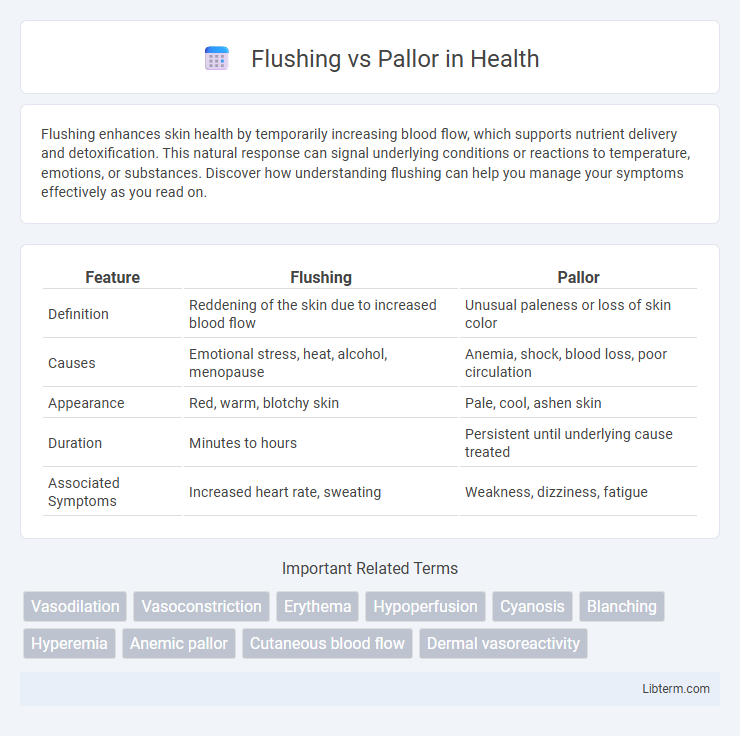Flushing enhances skin health by temporarily increasing blood flow, which supports nutrient delivery and detoxification. This natural response can signal underlying conditions or reactions to temperature, emotions, or substances. Discover how understanding flushing can help you manage your symptoms effectively as you read on.
Table of Comparison
| Feature | Flushing | Pallor |
|---|---|---|
| Definition | Reddening of the skin due to increased blood flow | Unusual paleness or loss of skin color |
| Causes | Emotional stress, heat, alcohol, menopause | Anemia, shock, blood loss, poor circulation |
| Appearance | Red, warm, blotchy skin | Pale, cool, ashen skin |
| Duration | Minutes to hours | Persistent until underlying cause treated |
| Associated Symptoms | Increased heart rate, sweating | Weakness, dizziness, fatigue |
Introduction to Flushing and Pallor
Flushing is characterized by a sudden reddening of the skin, primarily caused by increased blood flow to the superficial capillaries, often linked to emotions, temperature changes, or medical conditions such as rosacea or carcinoid syndrome. Pallor refers to an abnormal lightness of the skin, usually resulting from decreased blood flow or oxygenation, commonly associated with anemia, shock, or peripheral vascular disease. Both conditions serve as important clinical signs reflecting underlying physiological or pathological processes affecting skin coloration.
Defining Flushing: Causes and Characteristics
Flushing is characterized by a sudden, temporary reddening of the skin, often concentrated on the face, neck, or upper chest, caused by increased blood flow to superficial capillaries. Common causes of flushing include emotional triggers such as stress or embarrassment, ingestion of certain foods or alcohol, medication side effects, and medical conditions like carcinoid syndrome or menopause. Unlike pallor, which involves a pale appearance due to reduced blood flow or decreased red blood cell content, flushing signifies vasodilation and enhanced perfusion of the skin.
Understanding Pallor: Key Features and Triggers
Pallor is characterized by an abnormal lightness of the skin, often caused by decreased blood flow or reduced oxygenation of hemoglobin, which contrasts sharply with the increased redness seen in flushing. Common triggers of pallor include anemia, shock, peripheral vasoconstriction, and chronic diseases that impair circulation or oxygen delivery. Understanding these key features helps differentiate pallor from flushing, guiding accurate diagnosis and appropriate medical interventions.
Physiological Mechanisms Behind Flushing
Flushing occurs due to the dilation of superficial blood vessels, leading to increased blood flow and a reddish appearance of the skin, primarily triggered by sympathetic nervous system activation and the release of vasodilatory substances like histamine and prostaglandins. In contrast, pallor results from vasoconstriction, reducing blood flow and causing pale skin, often linked to sympathetic stimulation during stress or cold exposure. The physiological mechanisms behind flushing involve complex neurovascular responses aimed at dissipating heat or reacting to allergens, infections, or emotional stimuli.
Biological Basis of Pallor
Pallor results from reduced oxyhemoglobin concentration in the skin due to vasoconstriction and decreased blood flow, leading to a pale appearance. It is primarily caused by diminished cutaneous perfusion often linked to sympathetic nervous system activation during stress, anemia, or shock. Unlike flushing, which involves vasodilation and increased blood flow, pallor reflects an underlying physiological reduction in peripheral blood volume or hemoglobin content.
Flushing vs Pallor in Clinical Diagnosis
Flushing and pallor are critical clinical signs used to assess underlying cardiovascular and autonomic conditions, where flushing indicates increased cutaneous blood flow due to vasodilation, commonly seen in conditions like carcinoid syndrome or mast cell activation. Pallor results from vasoconstriction or reduced blood flow, often signaling anemia, shock, or peripheral vascular disease. Accurate differentiation between flushing and pallor aids clinicians in diagnosing systemic pathologies and guiding appropriate management strategies.
Common Medical Conditions Linked to Flushing
Flushing is commonly linked to medical conditions such as rosacea, menopausal hot flashes, carcinoid syndrome, and pheochromocytoma, characterized by sudden redness and warmth of the skin, primarily on the face and neck. Pallor, in contrast, typically indicates anemia, shock, or peripheral vasoconstriction, presenting as an abnormal paleness of the skin due to reduced blood flow or hemoglobin levels. Understanding these distinct clinical presentations aids in diagnosing underlying vascular or hematologic disorders.
Health Disorders Associated with Pallor
Pallor is often linked to health disorders such as anemia, shock, and peripheral vascular disease, where reduced blood flow or decreased red blood cell count results in a pale skin appearance. Unlike flushing, which indicates increased blood flow and can signal conditions like fever or emotional stress, pallor typically reflects underlying issues like blood loss, heart failure, or chronic illness. Identifying pallor helps in diagnosing circulatory or hematologic disorders requiring prompt medical evaluation.
Diagnostic Approaches: Flushing versus Pallor
Flushing is characterized by sudden and transient redness of the skin due to vasodilation, whereas pallor results from reduced blood flow or decreased hemoglobin concentration leading to paleness. Diagnostic approaches include clinical examination, where flushing is often linked to conditions like carcinoid syndrome or rosacea, while pallor suggests anemia or hypovolemia. Laboratory tests such as complete blood count and serum tryptase, along with skin biopsy and imaging, help distinguish the underlying causes of flushing versus pallor.
Treatment and Management: Flushing and Pallor
Treatment and management of flushing focus on identifying and avoiding triggers such as spicy foods, alcohol, or emotional stress, combined with medications like antihistamines or beta-blockers to reduce symptoms. Pallor management involves treating the underlying cause, such as anemia, hypovolemia, or shock, often requiring iron supplements, blood transfusions, or fluid resuscitation. Both conditions benefit from careful monitoring and patient education to prevent recurrence and manage associated health risks effectively.
Flushing Infographic

 libterm.com
libterm.com